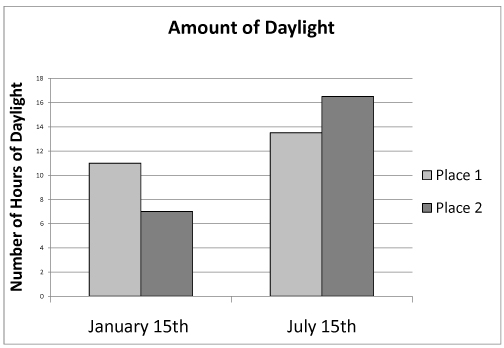Item CL043002: In the northern hemisphere, the farther north a place is from the equator, the lower is the maximum height that the sun reaches in the sky both in January and in July.
A student who lives at Place 1 measured the number of hours of sunlight on a day in January and on a day in July. Another student, who lives at Place 2 made the same measurement on the same two days. Both places are in the northern hemisphere.

Based on their measurements, as shown in the graph above, what must be TRUE about Place 2?
- Place 2 is closer to the Equator than Place 1.
- Place 2 is farther from the Equator than Place 1.
- Place 2 is farther to the east than Place 1.
- Place 2 could be north, south, or east of Place 1, because the number of hours of sunlight cannot be used to compare the location of one place to another.
- Distribution of Responses

- Students Responding Correctly
| Group | Correct | Total | Percent |
|---|---|---|---|
| Overall | 618 | 2220 | 28% |
| Grades | |||
| 6–8 | 328 | 1239 | 26% |
| 9–12 | 286 | 970 | 29% |
| Gender | |||
| Male | 320 | 1076 | 30% |
| Female | 279 | 1081 | 26% |
| Primary Language | |||
| English | 524 | 1905 | 28% |
| Other | 73 | 238 | 31% |
- Disciplinary Core Ideas
- ESS1.A Patterns of the apparent motion of the sun, the moon, and stars in the sky can be observed, described, predicted, and explained with models.
ESS1.B The orbits of Earth around the sun and of the moon around Earth, together with the rotation of Earth about an axis between its North and South poles, cause observable patterns. These include day and night; daily changes in the length and direction of shadows; and different positions of the sun, moon, and stars at different times of the day, month, and year.

